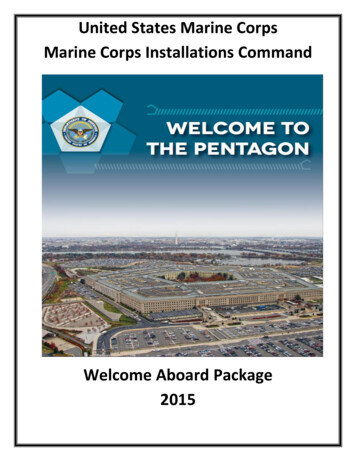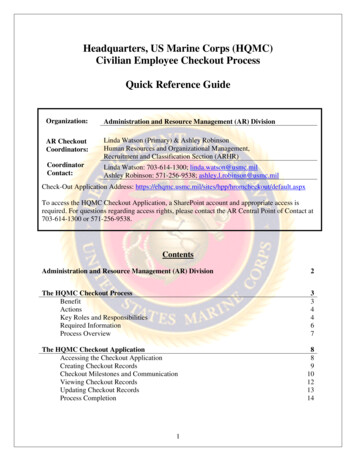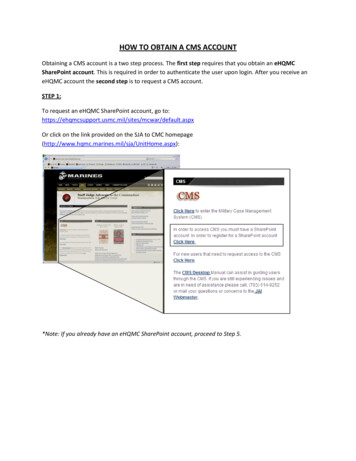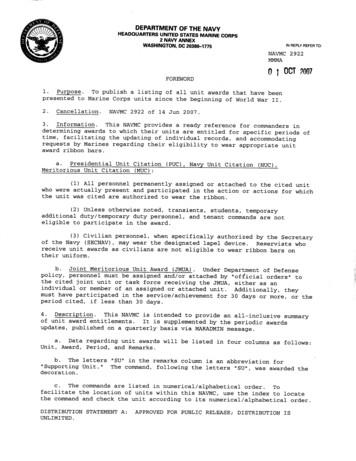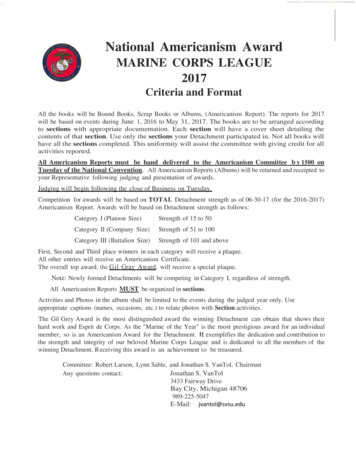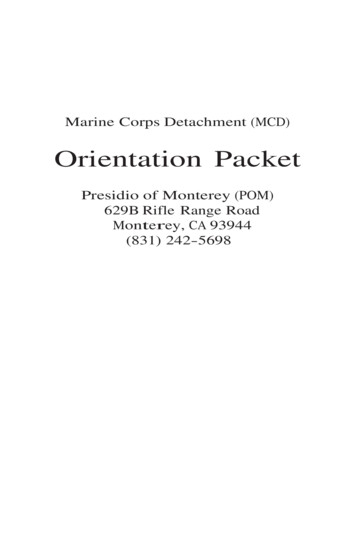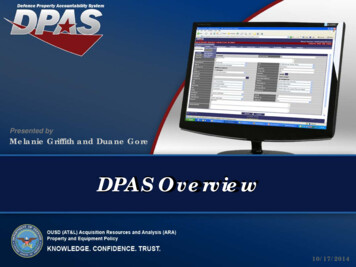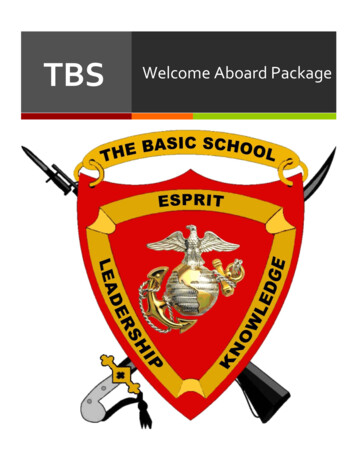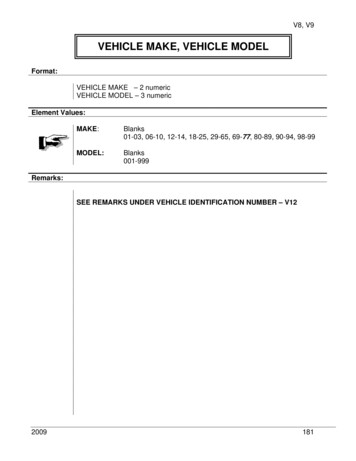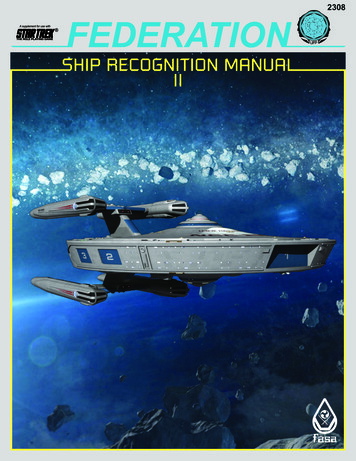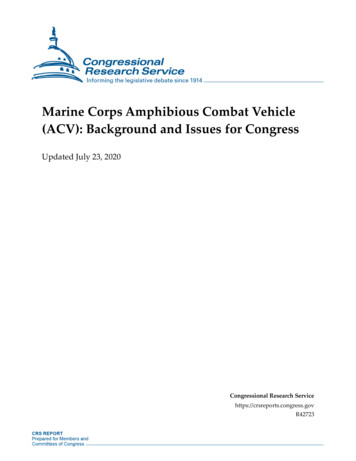
Transcription
Marine Corps Amphibious Combat Vehicle(ACV): Background and Issues for CongressUpdated July 23, 2020Congressional Research Servicehttps://crsreports.congress.govR42723
Marine Corps Amphibious Combat Vehicle (ACV): Background and Issues for CongressSummaryOn January 6, 2011, after spending approximately 3 billion in developmental funding, theMarine Corps cancelled the Expeditionary Fighting Vehicle (EFV) program due to poor reliabilitydemonstrated during operational testing and excessive cost growth. Because the EFV wasintended to replace the 40-year-old Amphibious Assault Vehicle (AAV), the Pentagon pledged tomove quickly to develop a “more affordable and sustainable” vehicle to replace the EFV. TheAmphibious Combat Vehicle (ACV) is intended to replace the AAV, incorporating some EFVcapabilities but in a more practical and cost-efficient manner. In concert with the ACV, theMarines were developing the Marine Personnel Carrier (MPC) to serve as a survivable andmobile platform to transport Marines when ashore. The MPC was not intended to be amphibiouslike an AAV, EFV, or the ACV but instead would be required to have a swim capability for inlandwaterways such as rivers, lakes, and other water obstacles such as shore-to-shore operations in thelittorals. Both vehicles were intended to play central roles in future Marine amphibiousoperations. On June 14, 2013, Marine leadership put the MPC program “on ice” due to budgetarypressures but suggested the program might be resurrected some 10 years down the road whenbudgetary resources might be more favorable.In what was described as a “drastic shift,” the Marines decided to “resurrect” the MPC in March2014. The Marines designated the MPC as ACV Increment 1.1 and planned to acquire about 200vehicles. The Marines also planned to develop ACV Increment 1.2, a tracked, fully amphibiousversion, and at the time planned to acquire about 470 vehicles and fund an ongoing high waterspeed study. Although ACV Increment 1.1 is to have a swim capability, another mode of transport(ship or aircraft) would be required to get the vehicles from ship to shore. The Marines arereportedly exploring the possibility of developing a high water speed ACV 2.0, which couldaccompany tanks and light armored vehicles into combat.On November 5, 2014, the Marines released a draft Request for Proposal (RFP) for ACVIncrement 1.1. On November 24, 2015, the Marine Corps awarded BAE Systems and SAICcontracts to develop ACV 1.1 prototypes for evaluation. BAE’s contract was for 103.8 millionand SAIC’s for 121.5 million, and each company was to build 16 prototypes to be tested overthe next two years. Both BAE and SAIC delivered their prototypes early, and Engineering andManufacturing Development (EMD) testing began mid-March 2017. In early December 2017, theMarines reportedly sent the ACV 1.1 down select request for proposals to BAE and ScienceApplications International Corporation (SAIC).On June 19, 2018, the Marine Corps selected BAE Systems to produce the ACV. The initialcontract—valued at 198 million—was for low-rate production of 30 vehicles to be delivered bythe autumn of 2019. On April 10, 2019, during testimony to the Senate Armed ServicesCommittee, Navy and Marine Corps leadership announced that during the fall of 2018, ACV 1.1prototypes demonstrated satisfactory water mobility performance in high surf conditions and, indoing so, met the full water mobility transition requirement for ACV 1.2 capability. As a result,ACV 1.1 and ACV 1.2 were to be consolidated into a single variant—the ACV—which isintended to replace all AAVs.A potential issue for Congress is the March 2020 proposed Marine Corps Force RedesignInitiative and how it might affect overall ACV requirements.Congressional Research Service
Marine Corps Amphibious Combat Vehicle (ACV): Background and Issues for CongressContentsBackground . 1Significance for Congress. 2The Marines’ Justification for the ACV and MPC . 2ACV . 2MPC . 2Desired Operational Capabilities . 2ACV . 2MPC . 3Expeditionary Advance Base Operations (EABO) . 3Past Programmatic Activities . 42013 Decision to “Shelve” the MPC . 4MPC Becomes ACV 1.1. 5Marines Release Request for Information (RFI) for ACV Increment 1.1 . 5Marines Release Draft Request for Proposal (RFP) for ACV Increment 1.1 . 6Additional Details on 2015 ACV 1.1 RFP . 6ACV 1.1 Fielding Plan . 6Marines Award ACV 1.1 Contracts . 7General Dynamics Land Systems (GDLS) Protests Contract Awards to theGovernment Accountability Office (GAO) . 7GAO Denies GDLS Protest . 8BAE Systems and SAIC Deliver ACV 1.1 Prototypes Early and EMD Testing Begins . 8Marine Corps Down Select Final Proposals . 8Annual Required GAO Report on the ACV Program . 8BAE Wins ACV Competition . 9Navy Awards BAE Contract for ACV Lot 2 . 9Director, Operational Test and Evaluation (DOT&E) FY2018 Annual Report . 9Director, Operational Test and Evaluation (DOT&E) FY2019 Annual Report . 10ACV 1.2 Requirements . 10Ship-to-Shore Requirements for the Next ACV Version . 10ACV 1.1 and ACV 1.2 Consolidated . 11Navy Awards BAE Contract for ACV Lot 3 . 11ACV 2.0. 11Department of Defense FY2021 Budget Request . 12FY2021 National Defense Authorization Act (NDAA) . 12S. 4049 . 12H.R. 6395 . 12FY2021 Defense Appropriations Bill . 12Potential Issue for Congress . 13Proposed Marine Corps Force Redesign Initiative and ACV Requirements. 13TablesTable 1. FY2021 DOD Budget Request—ACV . 12Congressional Research Service
Marine Corps Amphibious Combat Vehicle (ACV): Background and Issues for CongressContactsAuthor Information. 13Congressional Research Service
Marine Corps Amphibious Combat Vehicle (ACV): Background and Issues for CongressBackgroundU.S. Code, Title 10, Section 5063, United States Marine Corps: Composition and Functions,dated October 1, 1986, states the following:The Marine Corps will be organized, trained and equipped to provide an amphibious andland operations capability to seize advanced naval bases and to conduct naval landcampaigns.In this regard, the Marines are required by law to have the necessary equipment to conductamphibious operations and land operations. The ACV and MPC were considered integral systemsby the Department of Defense (DOD) and Marine Corps to meet this legal requirement, as well asproviding critical capabilities to execute the nation’s military strategy.On January 6, 2011, after spending approximately 3 billion in developmental funding, theMarine Corps—with “encouragement” from DOD—cancelled the Expeditionary Fighting Vehicle(EFV) program. The EFV was intended to replace the 40-year-old Amphibious Assault Vehicle(AAV), which currently transports Marines from ships to shore under hostile conditions. TheMarine Corps cancelled the EFV due to excessive cost growth and poor performance inoperational testing. Recognizing the need to replace the AAV, the Pentagon pledged to movequickly to develop a “more affordable and sustainable” vehicle to take the place of the EFV. TheAmphibious Combat Vehicle (ACV) is intended to replace the AAV, incorporating some EFVcapabilities but in a more practical and cost-efficient manner.In concert with the ACV, the Marines were developing the Marine Personnel Carrier (MPC) toserve as a survivable and mobile platform to transport Marines when ashore. At present, theMarines do not have a wheeled armored fighting vehicle that can operate as a dedicated infantrycarrier with Marine maneuver forces inland. The MPC was not intended to be amphibious like anAAV, EFV, or the ACV but instead would be required to have a swim1 capability for inlandwaterways such as rivers, lakes, and other water obstacles such as shore-to-shore operations in thelittorals. Because of a perceived amphibious “redundancy,” some have questioned the need forboth the ACV and MPC. In June 2013, citing budgetary pressures, the Marines reportedly put theMPC program “on ice” and suggested that it might not be resurrected for about 10 years.2With the Marines involved in decades-long land conflicts in Iraq and Afghanistan andproliferating anti-access technologies such as guided missiles, some analysts questioned whetherthe Marines would ever again be called on to conduct a large-scale amphibious assault operation.In response to these questions and the perceived need to examine the post-Iraq and AfghanistanMarine Corps, the Department of the Navy and DOD studied the requirement to conduct largescale amphibious operations and in early 2012 released a strategic vision for how amphibiousoperations will be conducted in the future. The primary assertion of this study was that theMarine Corps’ and Navy’s amphibious capabilities served a central role in the defense of theglobal interests of a maritime nation. The need to maintain an amphibious assault capability wasviewed by Marine Corps leadership as establishing the requirement for the ACV and MPC (asdiscussed in greater detail below).An amphibious capability generally refers to a vehicle’s ability to debark from a ship offshore at a considerabledistance and then move under fire to shore. A swim capability refers to a vehicle’s ability to traverse limited waterobstacles such as streams, rivers, and smaller bodies of inland water.2 Lee Hudson, “Marines Put Marine Personnel Carrier on Shelf Due to Budget Constraints,” InsideDefense, June 14,2013.1Congressional Research Service1
Marine Corps Amphibious Combat Vehicle (ACV): Background and Issues for CongressSignificance for CongressCongress is responsible for authorizing and appropriating funds for all weapon systems programs,including the ACV. In its oversight role, Congress could be concerned about how the ACVenables the Marines to conduct not only amphibious operations but also operations ashore.Another possible congressional concern is to what extent a robust amphibious assault capability isa necessary component of U.S. national security. Cost is another issue of interest to Congress.The Marines’ Justification for the ACV and MPCACVAt present, the Marines use the AAV-7A1 series amphibious assault vehicle to move Marinesfrom ship to shore. The Marines have used the AAV since 1971 and expect to continue to use ituntil replaced by the ACV. Over the years, the Marines claimed the AAV has become increasinglydifficult to operate, maintain, and sustain. As weapons technology and threat capabilities haveevolved since the early 1970s, the AAV—despite upgrades—is viewed as having capabilitiesshortfalls in the areas of water and land mobility performance, lethality, protection, and networkcapability. The AAV’s two-mile ship-to-shore range is viewed by many as a significantsurvivability issue not only for the vehicle itself but also for naval amphibious forces.MPCAlthough the AAV has some armor protection and can operate inland to a limited extent, it is notintended for use as an infantry combat vehicle. The Marines do have the LAV-25, Light ArmoredVehicle-25, an eight-wheeled armored vehicle that carries a crew of three and six additionalmarines. The LAV-25 is armed with a 25 mm chain gun and a 7.62 mm machine gun but is notfully amphibious, as it cannot cross a surf zone and would get to the beach via some type ofconnector such as the Landing Craft, Air Cushioned (LCAC). The LAV-25 has been in servicesince 1983. According to the Marine Program Executive Office (PEO) Land Systems, the LAV isnot employed as an armored personnel carrier and usually carries a four-person Marinescout/reconnaissance team in addition to its crew.3 In this regard, the MPC was viewed asnecessary by Marine leadership for the transport and enhanced armor protection of Marineinfantry forces.Desired Operational CapabilitiesACV4The Marines’ 2011 Request for Information (RFI)5 to industry provided an overview of theoperational requirements for the ACV. These requirements included the following:3Program Executive Office (PEO) Land Systems Marine Personnel Carrier Fact Sheet, 2010.Unless otherwise noted, information in this section is taken from the Amphibious Vehicle Request for Information(RFI) issued by the Marine Corps Systems Command on February 11, 2011.5 The Federal Acquisition Regulation defines an RFI as “a document used to obtain price, delivery, other marketinformation, or capabilities for planning purposes when the Government does not presently intend to issue asolicitation. [FAR 15.202(e)].”4Congressional Research Service2
Marine Corps Amphibious Combat Vehicle (ACV): Background and Issues for Congress The proposed vehicle must be able to self-deploy from amphibious shipping anddeliver a reinforced Marine infantry squad (17 Marines) from a launch distance ator beyond 12 miles with a speed of not less than 8 knots in seas with 1-footsignificant wave height and must be able to operate in seas up to 3-footsignificant wave height.The vehicle must be able to maneuver with the mechanized task force forsustained operations ashore in all types of terrain. The vehicle’s road and crosscountry speed as well as its range should be greater than or equal to the M-1A1tank.The vehicle’s protection characteristics should be able to protect against directand indirect fire and mines and improvised explosive device (IED) threats.The vehicle should be able to accommodate command and control (C2) systemsthat permit it to operate both at sea and on land. The vehicle, at a minimum,should have a stabilized machine gun in order to engage enemy infantry and lightvehicles.MPC6The Marine Corps’ 2011 Request for Information (RFI) to industry provided an overview of theoperational requirements for the MPC. These requirements included the following: The vehicle must accommodate nine Marines and two crew members and have a“robust tactical swim capability (shore-to-shore [not designed to embark from anamphibious ship]) and be capable of operating at 6 knots in a fully developedsea.”7The vehicle must be able to operate on land with M-1A1 tanks in mechanizedtask forces across the Marine Corps’ mission profile.The vehicle shall provide protection for the occupants from the blasts, fragments,and incapacitating effects of attack from kinetic threats, indirect fire, andimprovised explosive devices and mines.The vehicle shall be capable of firing existing Marine anti-structure and antiarmor missiles and should be able to accommodate existing command andcontrol (C2) systems.Expeditionary Advance Base Operations (EABO)Defense officials noted the Marine Corps is “not currently organized, trained and equipped to facea peer adversary in the year 2025”8 and enemies with advanced air and shore defense will makeamphibious operations even riskier. To counter this, the Navy is developing the Expeditionary6Unless otherwise noted, information in this section is taken from Annex A: Marine Personnel Carrier (MPC) Familyof Vehicles (FOV) Requirements Set to the Marine Personnel Carrier Request for Information (RFI), February 17,2011.7 Annex A: Marine Personnel Carrier (MPC) Family of Vehicles (FOV) Requirements Set to the Marine PersonnelCarrier Request for Information (RFI), February 17, 2011.8 Jeff Schogol, “The Next Fight: The Commandant is Pushing the Corps to be Ready for a Violent, Violent Fight,”Marine Corps Times, September 18, 2017.Congressional Research Service3
Marine Corps Amphibious Combat Vehicle (ACV): Background and Issues for CongressAdvance Base Operations (EABO) operational concept to address these concerns. EABO isdescribed as follows:Expeditionary Advance Base Operations is a naval operational concept that anticipates therequirements of the next paradigm of US Joint expeditionary operations. The concept isadversary based, cost informed and advantage focused. EABO calls for an alternative,difficult to target forward basing infrastructure that will enable US naval and joint forcesto create a more resilient forward based posture to persist, partner and operate within rangeof adversary long range precision fires. The alternative forward posture enabled byExpeditionary Advance Bases (EABs) is designed to mitigate the growing threat posed bythe abundant quantity, expanded range and enhanced precision of potential adversaryweaponry—particularly ballistic and cruise missiles designed to attack critical joint fixedforward infrastructure and large platforms. EABs provide a dispersed and largely mobileforward basing infrastructure that enables a persistent alternative force capability set thatis similarly designed to be difficult to target and inherently resilient. The resi
Jul 23, 2020 · speed study. Although ACV Increment 1.1 is to have a swim capability, another mode of transport (ship or aircraft) would be required to get the vehicles from ship to shore. The Marines are reportedly exploring the possibility of developing a high water speed ACV 2.0, which coul
